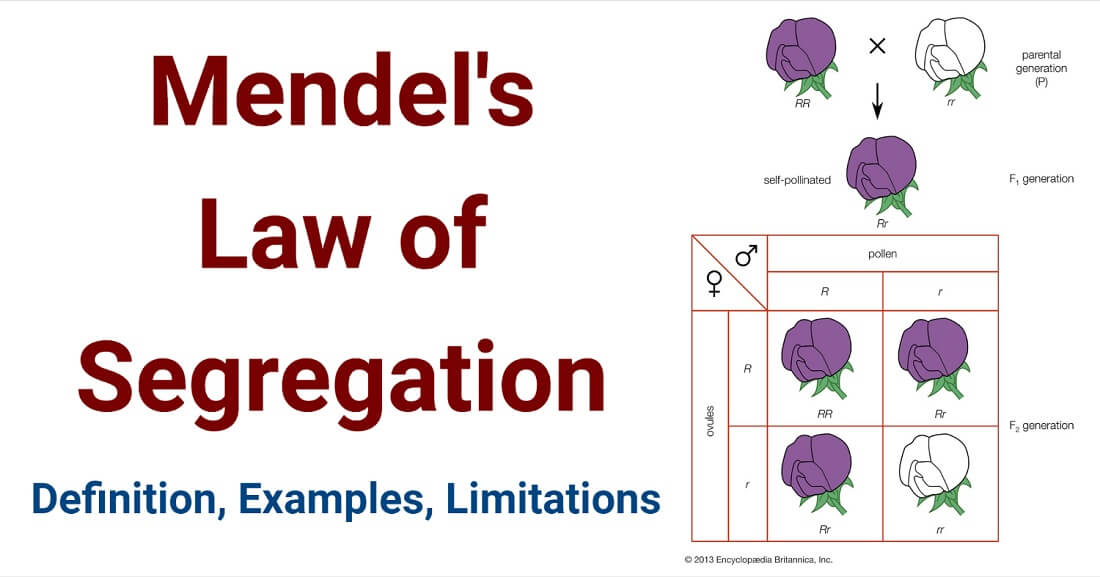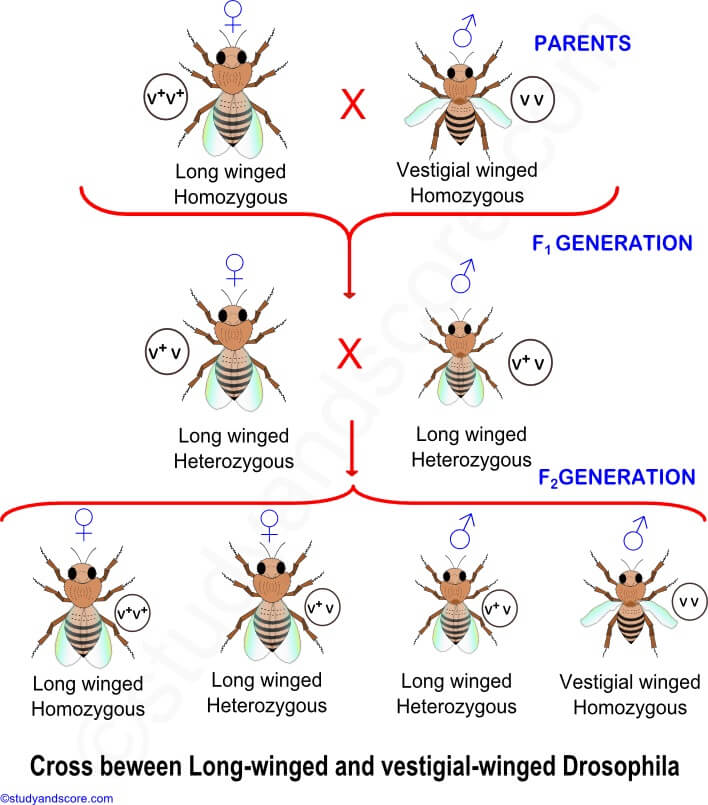Mendel’s Law of Segregation Definition
Mendel’s Law of Segregation states that ‘The hybrids or heterozygotes of F1 generation have two contrasting characters of dominant and recessive nature where the alleles though remain together for a long time do not contaminate or mix with each other and separate or segregate at the time of gametogenesis so that each gamete receives only one allele of a character either dominant or recessive.’
- In simple words, the law states that only a single gene copy from a parent is distributed in a gamete, and the allocation of the gene copies is entirely random.
- Mendel’s law of segregation is based on a number of concepts;
- a gene exists in more than one form of an allele.
- during the formation of gametes, the allelic pair of a gene separate so that each gamete has a single allele.
- all organisms inherit two alleles for a genetic trait.
- the two alleles obtained for a trait are different as one is dominant and the other is recessive.
- The law of segregation enables the use of Punnett square for the estimation of resulting genotypes from a cross as it is based on the equal segregation of alleles.
- The law of segregation is significant as it introduced the concept of hereditary factors that remain as separate entities even when present together with other similar entities.
- The law was used to disprove a blending theory by the generation of traits encoded by recessive alleles in the F1 generation.

Image Source: Encyclopædia Britannica.
Mendel’s Law of Segregation Characteristics
- Mendel’s law of segregation is based on the first phase of the meiotic cell division, where the homologous chromosomes with two copies of the same gene are segregated into individual daughter nuclei.
- The division of homologous chromosomes during meiosis can account for the segregation of the alleles at the gene locus to form different gametes.
- The mechanisms of segregation can be explained better with an example of a monohybrid cross between tall and dwarf pea plants.
- It can be assumed that the homozygous tall pea plant has the allele RR, and the short pea plants have the allele rr.
- The parent with the RR alleles produces the gametes with a single R allele, and the pea plant with rr alleles produces gametes with a single r allele.
- As a gamete can only contain a single chromosome of a homologous pair, each gamete carries a single allele.
- During the crossing, the gametes fuse to form a heterozygous or hybrid plant with Rr alleles consisting of both dominant and recessive alleles.
- As a result of incomplete dominance, the dominant R allele partially expresses itself in the hybrid of the first generation while the recessive allele remains unexpressed.
- In heterozygous individuals, both the alleles remain together for a long time but do not interfere or affect each other.
- In the monohybrid cross, the gametes can combine to form three possible diploid genotypes; RR, Rr, rr.
Examples of Mendel’s Law of Segregation
1. Morgan’s work on Drosophila
- T. H Morgan worked on Drosophila, where he crossed homozygous long-winged Drosophila with homozygous vestigial-winged Drosophila.
- During the cross, the process of segregation can be observed if we assume that the long-winged Drosophila has a pair of v+v+ alleles for the long wings and the vestigial-winged Drosophila has vv alleles for the vestigial wings.
- The long-winged Drosophila produces a gamete with a single v+ allele, and the vestigial-winged Drosophila also produces a gamete with v allele.
- The gametes fuse to form hybrids with v+v alleles observed phenotypically as long-winged Drosophila as v+ is the dominant allele.
- This example shows how the alleles are separated during gamete formation and unite to produce three distinct genotypes in the hybrids.

Image Source: Study and Score.
2. Albinism in humans
- Another example of the law of segregation can be observed in the case of albinism in human beings.
- Albinism is the lack of pigment production in humans due to the presence of an abnormal recessive trait.
- The dominant allele for albinism is represented by A, and the recessive allele is represented by a.
- The cross between a homozygous individual with alleles AA and aa result in gametes A and a.
- The gametes fuse to form hybrids with Aa alleles where the dominant (no albinism) trait allele is expressed.
- However, further crossing results in hybrids with AA and aa alleles where the aa alleles result in albinism.
- The presence of the recessive aa genes results in the lack of production of the tyrosinase enzyme required for the synthesis of melanin.
Limitations of Mendel’s Law of Segregation
Even though the Law of Segregation has been considered one of the most important findings in genetics, there are several limitations with the concept. The following are some of them;
- The law is only applicable to diploid organisms that are formed from haploid gametes during sexual reproduction.
- The law doesn’t hold true in the case of alleles that exhibit incomplete dominance or codominance.
- The law is applicable for traits encoded by gene pairs with two alleles where one is dominant over the other.
- The law is not valid for genes that are collaborative and might vary in expression. The law also doesn’t work for genes that are complementary.
- It doesn’t hold true for traits that are encoded by more than one gene pair.
References and Sources
- Verma PS and Agarwal VK (3005). Cell Biology, Genetics, Molecular Biology, Evolution, and Ecology. Multicolored Edition.
- https://www.thoughtco.com/mendels-law-of-segregation-373472 – 5%
- https://biologydictionary.net/law-of-segregation/ – 5%
- https://www.vedantu.com/biology/law-of-segregation-law-of-dominance – 4%
- https://thefactfactor.com/facts/pure_science/biology/genetics/mendels-laws-of-inheritance/10080/ – 4%
- https://www.k-state.edu/parasitology/biology198/mendel.html – 4%
- https://www.bartleylawoffice.com/the-main/where-in-mitosis-and-or-meiosis-does-the-principle-of-segregation-mendels-first-law-occur.html – 2%
- https://geneticsstudy.blogspot.com/2009/08/genetic-control-of-metabolism.html – 1%
- https://www.coursehero.com/file/p3o2ae5r/Traits-that-are-encoded-by-more-than-one-gene-2-The-effects-of-the-environment/ – 1%
- https://www.answers.com/Q/How_the_punnett_squares_use_the_law_of_segregation – 1%
